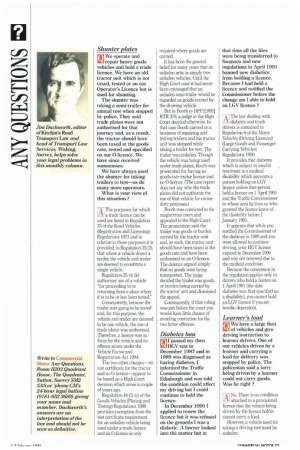Shunter plates
Page 25

If you've noticed an error in this article please click here to report it so we can fix it.
We operate and repair heavy goods vehicles and hold a trade licence. We have an old tractor tmit which is not taxed, tested or on our Operator's Licence but is used for shunting.
The shunter was taking a semi-trailer for annual test when stopped by police. They said trade plates were not authorised for that journey and, as a result, the tractor should have been taxed at the goods rate, tested and specified on our 0-licence. We have since received summonses.
We have always used the shunter for taking trailers to test—as do many more operators.
What is your view of this situation ?
/T The purposes for which a trade licence can be used are listed in Regulation 35 of the Road Vehicles (Registration and Licensing) Regulations 1971 and in relation to those purposes it is provided. in Regulation 35 (2), that where a vehicle draws a trailer, the vehicle and trailer are deemed to constitute a single vehicle.
Regulation 35(4) (k) authorises use of a vehicle "for proceeding to or returning from a place where it is to be or has been tested."
Consequently, because the trailer was going to be tested and, for this purpose, the vehicle and trailer are deemed to be one vehicle, the use of trade plates was authorised. Therefore, a licence was in force for the vehicle and no offence arises under the Vehicle Excise and Registration Act 1994.
The two other charges—no test certificate for the tractor and no 0-licence—appear to be based on a High Court decision which arose a couple of years ago.
Regulation 44(1) (c) of the Goods Vehicles (Plating and Testing) Regulations 1988 provides exemption from the test certificate requirement for an unladen vehicle being used under a trade licence and an 0-licence is only required where goods are carried.
It has been the general belief for many years that an unladen artic is simply two unladen vehicles. Until the High Court case it had never been envisaged that an unladen semi-trailer would be regarded as goods carried by the drawing vehicle.
But in Booth vs DPP [1993] RTR 379, a judge in the High Court decided otherwise. In that case Booth carried on a business of repairing and testing trailers and his tractor unit was stopped while taking a trailer for test. The trailer was unladen. Though the vehicle was being used under trade plates, Booth was prosecuted for having no goods-rate excise licence and no 0-licence. (The case report does not say why the trade plates did not authorise the use of that vehicle for excise duty purposes.) Booth was convicted in the magistrates court and appealed to the High Court. The prosecution said the trailer was goods or burden carried by the tractor unit and, as such, the tractor unit should have been taxed at the goods rate and have been authorised on an 0-licence. The defence argued simply that no goods were being transported. The judge decided the trailer was goods or burden being carried by the tractor unit and dismissed the appeal.
Consequently, if that ruling was put before the court you would have little chance of avoiding conviction for the two latter offences
































































































